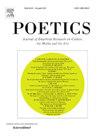Designed for success or failure: Differences in funding and rejection in the space of applications to the Danish Art Foundation among craftsmen and designers
IF 1.7
2区 社会学
0 LITERATURE
引用次数: 0
Abstract
Craft and design are art forms that teeter on the boundary of being considered art. Because of this, these mediums are an ideal case to examine how the Danish Art Foundation funds these arts and what this says about the distinction of the arts in a Danish context. This article analyses 1898 full-text applications for funding - both the ones that have been awarded funding and the ones that have been rejected - of craftsmen and designers from a five-year range. The applications are analysed with hierarchical Stochastic Block Modelling and Class Specific Correspondence Analysis to reduce the complexity of the data. Using these methods, the structures of both the overall meta-field and the discipline-specific subfields become apparent, and so do the different degrees of homologies and heterologies between subfields and the meta-field and the field of art. Exemplified by four subfields, we identify four different types of homology/heterology: a full homology, a secondary homology, a heterologous artistic pole, and a full heterology. That some subfields of craft and design are homologous to the field of art while others are heterologous exemplifies the process of artification from an institutional perspective. The criteria for being considered artistic varies from subfield to subfield, with some having homologous structures to the art field, while others show a clear heterologous structure, highlighting that subfields can be autonomous from a common meta-field. Some subfields are, however, neither fully homologous nor heterologous but exhibit a mix of both logics. This article hopes to add to the discussion of methods for determining field autonomy and what fields can be autonomous from.
为成功或失败而设计:在申请丹麦艺术基金会的工匠和设计师之间,资金和拒绝的差异
工艺和设计是在被认为是艺术的边界上摇摇欲坠的艺术形式。正因为如此,这些媒介是一个理想的案例,可以用来研究丹麦艺术基金会如何资助这些艺术,以及这说明了丹麦背景下艺术的区别。本文分析了五年间1898份由工匠和设计师提出的资助申请全文,包括获得资助的申请和被拒绝的申请。应用分层随机块建模和类特定对应分析来降低数据的复杂性。通过这些方法,整体元场和特定学科的子场的结构变得清晰,子场与元场和艺术场之间的不同程度的同质和异质也变得清晰。以四个子领域为例,我们确定了四种不同类型的同源/异源:完全同源、次级同源、异源艺术极点和完全异源。工艺和设计的一些子领域与艺术领域是同源的,而其他子领域则是异源的,这从制度的角度例证了人工的过程。被视为艺术的标准因子领域而异,有些与艺术领域具有同源结构,而另一些则显示出明显的异源结构,强调子领域可以从共同的元领域独立出来。然而,有些子域既不是完全同源的,也不是完全异源的,而是表现出两种逻辑的混合。本文希望对确定域自治的方法以及哪些域可以自治进行讨论。
本文章由计算机程序翻译,如有差异,请以英文原文为准。
求助全文
约1分钟内获得全文
求助全文
来源期刊

Poetics
Multiple-
CiteScore
4.00
自引率
16.00%
发文量
77
期刊介绍:
Poetics is an interdisciplinary journal of theoretical and empirical research on culture, the media and the arts. Particularly welcome are papers that make an original contribution to the major disciplines - sociology, psychology, media and communication studies, and economics - within which promising lines of research on culture, media and the arts have been developed.
 求助内容:
求助内容: 应助结果提醒方式:
应助结果提醒方式:


